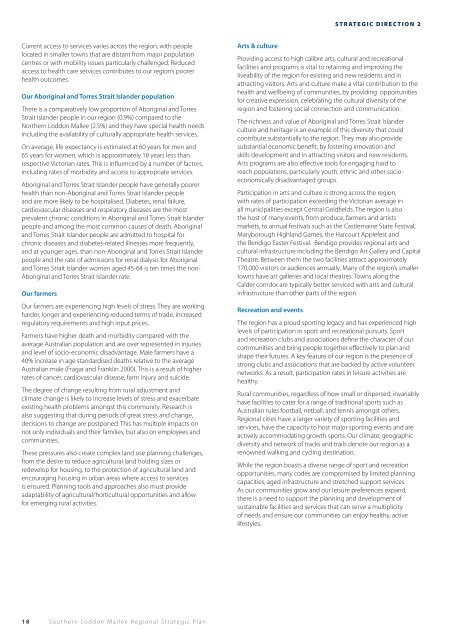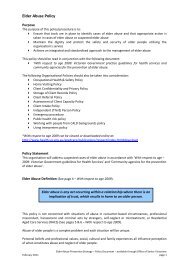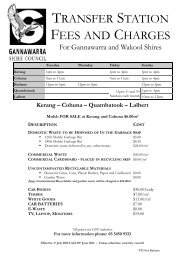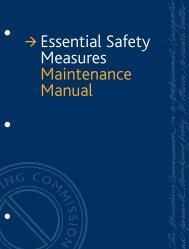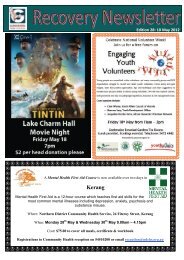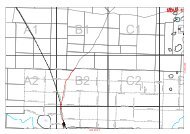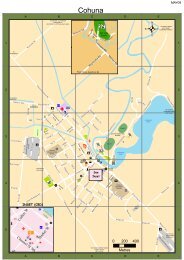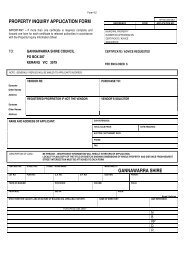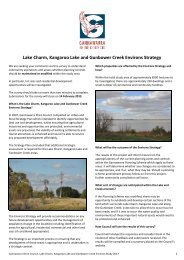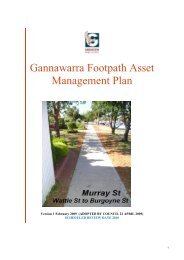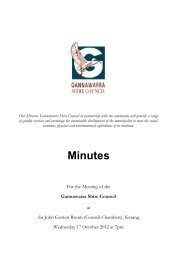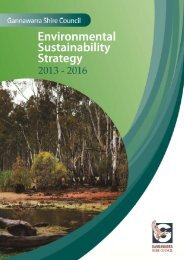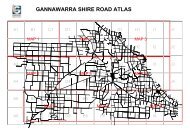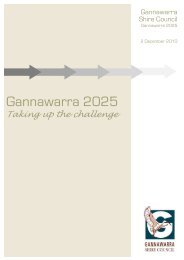Southern Loddon Mallee Regional Strategic Plan 1 - Macedon ...
Southern Loddon Mallee Regional Strategic Plan 1 - Macedon ...
Southern Loddon Mallee Regional Strategic Plan 1 - Macedon ...
Create successful ePaper yourself
Turn your PDF publications into a flip-book with our unique Google optimized e-Paper software.
Current access to services varies across the region, with people<br />
located in smaller towns that are distant from major population<br />
centres or with mobility issues particularly challenged. Reduced<br />
access to health care services contributes to our region’s poorer<br />
health outcomes.<br />
Our Aboriginal and Torres Strait Islander population<br />
There is a comparatively low proportion of Aboriginal and Torres<br />
Strait Islander people in our region (0.9%) compared to the<br />
Northern <strong>Loddon</strong> <strong>Mallee</strong> (2.5%) and they have special health needs<br />
including the availability of culturally appropriate health services.<br />
On average, life expectancy is estimated at 60 years for men and<br />
65 years for women, which is approximately 18 years less than<br />
respective Victorian rates. This is influenced by a number of factors,<br />
including rates of morbidity and access to appropriate services.<br />
Aboriginal and Torres Strait Islander people have generally poorer<br />
health than non-Aboriginal and Torres Strait Islander people<br />
and are more likely to be hospitalised. Diabetes, renal failure,<br />
cardiovascular diseases and respiratory diseases are the most<br />
prevalent chronic conditions in Aboriginal and Torres Strait Islander<br />
people and among the most common causes of death. Aboriginal<br />
and Torres Strait Islander people are admitted to hospital for<br />
chronic diseases and diabetes-related illnesses more frequently,<br />
and at younger ages, than non-Aboriginal and Torres Strait Islander<br />
people and the rate of admissions for renal dialysis for Aboriginal<br />
and Torres Strait Islander women aged 45-64 is ten times the non-<br />
Aboriginal and Torres Strait Islander rate.<br />
Our farmers<br />
Our farmers are experiencing high levels of stress. They are working<br />
harder, longer and experiencing reduced terms of trade, increased<br />
regulatory requirements and high input prices.<br />
Farmers have higher death and morbidity compared with the<br />
average Australian population and are over represented in injuries<br />
and level of socio-economic disadvantage. Male farmers have a<br />
40% increase in age standardised deaths relative to the average<br />
Australian male (Fragar and Franklin 2000). This is a result of higher<br />
rates of cancer, cardiovascular disease, farm injury and suicide.<br />
The degree of change resulting from rural adjustment and<br />
climate change is likely to increase levels of stress and exacerbate<br />
existing health problems amongst this community. Research is<br />
also suggesting that during periods of great stress and change,<br />
decisions to change are postponed. This has multiple impacts on<br />
not only individuals and their families, but also on employees and<br />
communities.<br />
These pressures also create complex land use planning challenges,<br />
from the desire to reduce agricultural land holding sizes or<br />
redevelop for housing, to the protection of agricultural land and<br />
encouraging housing in urban areas where access to services<br />
is ensured. <strong>Plan</strong>ning tools and approaches also must provide<br />
adaptability of agricultural/horticultural opportunities and allow<br />
for emerging rural activities.<br />
18 <strong>Southern</strong> <strong>Loddon</strong> <strong>Mallee</strong> <strong>Regional</strong> <strong>Strategic</strong> <strong>Plan</strong><br />
STRaTegIC DIReCTION 2<br />
Arts & culture<br />
Providing access to high calibre arts, cultural and recreational<br />
facilities and programs is vital to retaining and improving the<br />
liveability of the region for existing and new residents and in<br />
attracting visitors. Arts and culture make a vital contribution to the<br />
health and wellbeing of communities, by providing opportunities<br />
for creative expression, celebrating the cultural diversity of the<br />
region and fostering social connection and communication.<br />
The richness and value of Aboriginal and Torres Strait Islander<br />
culture and heritage is an example of this diversity that could<br />
contribute substantially to the region. They may also provide<br />
substantial economic benefit, by fostering innovation and<br />
skills development and in attracting visitors and new residents.<br />
Arts programs are also effective tools for engaging hard to<br />
reach populations, particularly youth, ethnic and other socioeconomically<br />
disadvantaged groups.<br />
Participation in arts and culture is strong across the region,<br />
with rates of participation exceeding the Victorian average in<br />
all municipalities except Central Goldfields. The region is also<br />
the host of many events, from produce, farmers and artists<br />
markets, to annual festivals such as the Castlemaine State Festival,<br />
Maryborough Highland Games, the Harcourt Applefest and<br />
the Bendigo Easter Festival. Bendigo provides regional arts and<br />
cultural infrastructure including the Bendigo Art Gallery and Capital<br />
Theatre. Between them the two facilities attract approximately<br />
170,000 visitors or audiences annually. Many of the region’s smaller<br />
towns have art galleries and local theatres. Towns along the<br />
Calder corridor are typically better serviced with arts and cultural<br />
infrastructure than other parts of the region.<br />
Recreation and events<br />
The region has a proud sporting legacy and has experienced high<br />
levels of participation in sport and recreational pursuits. Sport<br />
and recreation clubs and associations define the character of our<br />
communities and bring people together effectively to plan and<br />
shape their futures. A key feature of our region is the presence of<br />
strong clubs and associations that are backed by active volunteer<br />
networks. As a result, participation rates in leisure activities are<br />
healthy.<br />
Rural communities, regardless of how small or dispersed, invariably<br />
have facilities to cater for a range of traditional sports such as<br />
Australian rules football, netball, and tennis amongst others.<br />
<strong>Regional</strong> cities have a larger variety of sporting facilities and<br />
services, have the capacity to host major sporting events and are<br />
actively accommodating growth sports. Our climate, geographic<br />
diversity and network of tracks and trails denote our region as a<br />
renowned walking and cycling destination.<br />
While the region boasts a diverse range of sport and recreation<br />
opportunities, many codes are compromised by limited planning<br />
capacities, aged infrastructure and stretched support services.<br />
As our communities grow and our leisure preferences expand,<br />
there is a need to support the planning and development of<br />
sustainable facilities and services that can serve a multiplicity<br />
of needs and ensure our communities can enjoy healthy, active<br />
lifestyles.


